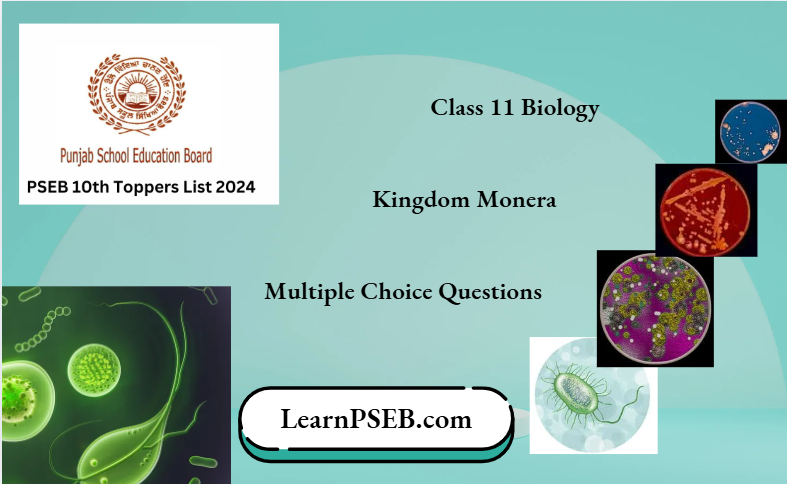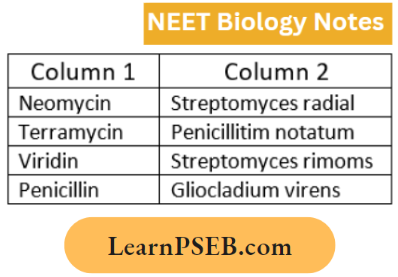Kingdom Monera Multiple Choice Questions
Question 1. From competitive examinations
Find out the comet match:
- Aids- bacillus anthesis
- Syphilis- treponema pallidum
- Gonorrhea- Leishmania donovani
- Urethritis- enthameaobea gingivalis
Answer: 2. Aids- bacillus anthesis
Question 2. Bt gene occurs in
- Bacillius thurigensis
- Escherichia coli
- Agrobacterium tumefaciens
- Rhixobium leguminosarum
Answer: 1. Bacillius thurigensis
Question 3. In which bacterial reproduction phage lake part?
- Conjugation
- Transformation
- Binary fission
- Transduction.
Answer: 4. Transduction.
Read And Learn More Class 11 Biology MCQs
Question 4. Mvcoplasmas arc not sensitive to :
- Penicillin
- Streptomycin
- Erythromycin
- Neomycin.
Answer: 1. Penicillin
PSEB 11th Class Biology Kingdom Monera MCQs

Question 5. Mitotic apparatus is absent in:
- Green algae
- Fungi
- Bacteria
- Higher plants.
Answer: 3. Bacteria
Question 6. Teichoic acid is present in the cell wall of:
- Bacteriophage
- Mycoplasma
- Nostoc
- Pneumococcus.
Answer: 4. Pneumococcus.
Question 7. Disease pneumonia is due to:
- Virus
- Bacterium
- Cyanobacterium
- Protozoan.
Answer: 2. Bacterium
Question 8. Bacteria cannot survive in highly salted pickles because:
- Bacteria do not get light for photosynthesis
- The pickle does not contain nutrients necessary for bacteria to live
- Salt inhibits reproduction
- Bacteria get plasmolysed and thus killed.
Answer: 4. Bacteria get plasmolysed and thus killed.
Question 9. A non-legume, symbiotic nitrogen-fixing bacterium is:
- Rhizobium
- Azotobacter
- Frankia
- Clostridium.
Answer: 3. Frankia
Question 10. What is true for photolithotrophs?
- Obtain energy from radiations and hydrogen from organic compounds
- Obtain energy from radiations and hydrogen from inorganic compounds
- Obtain energy from organic compounds
- Obtain energy from inorganic compounds.
Answer: 2. Obtain energy from radiations and hydrogen from inorganic compounds
Question 11. The difference in gram + ve and gram – ve bacteria is due to:
- Cell wall
- Cell membrane
- Ribosome
- Cytoplasm.
Answer: 1. Cell wall
Question 12. What is true for archaebacteria?
- All halophiles
- All photosynthetic
- All fossils
- Oldest living beings
Answer: 4. Oldest living beings
Question 13. Which of the following is not produced by in the lactose medium?
- Thiognlnclosidc transacetylase
- Lactose dehydrogenase
- Lactose permease
- I-galactosidase.
Answer: 2. Lactose dehydrogenase
Kingdom Monera Multiple Choice Questions PSEB Class 11
Question 14. The cell wall of a bacterium is composed of:
- Cellulose
- Chitinous
- Cellulose
- Chitin
- Mureill.
Answer: 4. Mureill.
Question 15. Plasmids occur in-
- Chromosomes
- Viruses
- Bacteria
- Chloroplasts.
Answer: 3. Bacteria
Question 18. Milk is changed into curd by:
- Acetobacter acetic
- Bailius megatherium
- Xanthomonas citri
- None.
Answer: 4. None.
Question 19. Match the names of antibiotics listed under column 1 with their sources given under column 2. Select the correct alphabet of two columns:

- A—p, b—r, c—s, d—q
- A—r, b—p, c—s, d—q
- A—s, b—p, c—r, d—q
- A—r, b—s, c—p, d—q.
Answer: 4. A—r, b—s, c—p, d—q.
Question 17. Which one of the following organisms may respire in the absence of oxygen?
- Azotobacter
- Clostridium
- Rhizobium
- Lactobacillus.
Answer: 2. Clostridium
Question 18. Milk is changed into cured by
- Acetobacter aceti
- Bacillus megatherium
- Xanthomonas citri
- None.
Answer: 4. None.
Kingdom Monera Multiple Choice Questions PSEB Class 11
Question 19. Bacteria prepare food by oxidation of:
- N2
- N03
- Oxygen
- Glycogen.
Answer: 4. Glycogen.
Question 20. Extrachromosomal material of bacteria is found in:
- Circular dna
- Extrachromosomal dna
- Chromosomal dna
- Plasmid.
Answer: 4. Plasmid.
Question 23. Which of the following is correct?
- Diatoms produce basodiopores
- Hererocycytes occur in Boston
- Fronds develop in bryophtes
- Multiciliates sperms occur in angiosperms
Answer: 2. Hererocycytes occur in Boston
Question 24. Mnrein does not occur in the wall of :
- Diatoms
- Nostoc
- Eubacteria
- Blue-green algae.
Answer: 1. Diatoms
Question 25. Bacterial flagella are made up of
- Chlorine
- Fluorine
- Iodine
- Bromine.
Answer: 1. Chlorine
Question 26. Bacterial flagella are made up of :
- Protein
- Amines
- Lipids
- Carbohydrates.
Answer: 1. Protein
Question 27. Bacterium pseudomonas is useful as it can :
- Transfer genes from one plant to another
- Fix atmospheric nitrogen
- Produce several antibiotics
- Decompose a variety of organic compounds.
Answer: 2. Fix atmospheric nitrogen
Question 28. Bacterial ribosomes are :
- 70S
- 60 S
- 80 S
- 50 S.
Answer: 1. 70S
Question 29. The iron-chelating substance is produced by a growth-promoting rhizobacterium:
- Rhizobium japonicum
- Azospirillium
- Pseudomonas putida
- Aspergillus.
Answer: 2. Azospirillium
PSEB Class 11 Biology Chapter Kingdom Monera MCQs
Question 30. Which one is not correctly matched :
- Streptomyces—antibiotic
- Serratia—drug addiction
- Rhizobium—biofertilizer
- Spirulina—single cell protein.
Answer: 2. Serratia—drug addiction
Question 31. Azolla has a symbiotic relationship with :
- Chlorella
- Anabaena
- Nostoc
- Tolypothrix.
Answer: 2. Anabaena
Question 32. The best well-studied batching-plant relationship is that of:
- Cymmbactcrinl symbiosis with some aquatic ferns
- Modulation in snbanla stem
- Tiall formation by ay, what Merriam
- Growth stimulation by phosphate bacteria.
Answer: 3. Tiall formation by ay, what Merriam
Question 33. Auxosporcs and oocysts are formed respectively by
- Several diatoms and a few cyanobacteria
- Several cyanobacteria and several diatoms
- Some diatoms and several cyanobacteria
- Some cyanobacteria and many diatoms.
Answer: 1. Several diatoms and a few cyanobacteria
Question 34. Barophilic prokaryotes:
- Grow slowly in highly alkaline frozen lakes at high altitudes
- Occur in water containing high concentrations of barium hydroxide
- Grow and multiply in very deep marine sediments
- Readily grow and divide in seawater enriched in any soluble salt of barium.
Answer: 1. Grow slowly in highly alkaline frozen lakes at high altitudes
Question 35. For retting of jute, the fermenting microbe used is:
- Helicobacter pylori
- Mesophilic bacteria
- Streptococcus lactis
- Butyric acid bacteria.
Answer: 4. Butyric acid bacteria.
Question 36. Gram-ve bacteria possess peptidoglycan and an extra layer of:
- Protein
- Lipoprotein
- Lipopolysaccharide
- Lipid.
Answer: 3. Lipopolysaccharide
PSEB Class 11 Biology Chapter Kingdom Monera MCQs
Question 37. Which of the following is a pathogenic bacterium of the colon
- Balantidium coli
- Entamoeba coli
- Enterobium vermicularis
- Escherichia coli.
Answer: 4. Escherichia coli.
Question 38. Nitrogen-fixing bacteria are associated with
- Malvaceae
- Gramineae
- Cruciferae
- Leguminasae
Answer: 4. Leguminasae
Question 39. Which of the following contain polyhedral bodies?
- Bacteria
- Nostoc
- Mycoplasma
- None of the above.
Answer: 2. Nostoc
Question 40. Inoculation against malaria is out of the question because:
- It does not produce antibodies and antitoxins
- Plasmodium produce antitoxins
- Plasmodium produces minute bodies
- None of the above.
Answer: 1. It does not produce antibodies and antitoxins
Question 41. Bacteria are considered plants because they :
- Have chlorophyll
- Have stomata
- Have rigid cell walls that are green in color
Answer: 3. Have rigid cell walls that are green in color
Question 42. Curing olten leaves is brought about by the activity of:
- Viruses
- Fungi
- Bacteria
- Myconhizn
Answer: 3. Bacteria
Question 43. In prokaryotes. Chromatophotvs atv
- Specialized granules responsible for the coloration of cells
- Structure is responsible for organizing the shape of (be organism
- Inclusion bodies lying five inside the cells for carrying out various metabolic activities
- Internal membrane systems that may become extensive and complex in photosynthetic bacteria
Answer: 4. Internal membrane systems that may become extensive and complex in photosynthctic bacteria.
Question 44. Which of the following is a flowering plant with modules containing filamentous nitrogen-fixing microorganisms?
- Crotalaria juncea
- Cycos revoluta
- Ciccr arietinwn
- Casuarina equisetifolia.
Answer: 4. Casuarina equisetifolia.
Question 45. Which one of the following statements is correct?
- Both azotobacter and rhizobium fix atmospheric nitrogen in root nodules of plants.
- Cyanobacteria such as anabasine and nostoc are important mobilizers of phosphates and potassium for plant nutrition in the soil.
- At present it is not possible to grow maize without chemical fertilizers.
- Extensive use of chemical fertilizers may lead to eutrophication of nearby water bodies.
Answer: 4. Extensive use of chemical fertilizers may lead to eutrophication of nearby water bodies.
Question 46. Which one of the following statements about mycoplasma is wrong?
- They are pleomorphic
- They are sensitive to penicillin
- They cause diseases in plants
- They are also called people.
Answer: 2. They are sensitive to penicillin
Question 47. Which one of the following is an example of a negative feedback loop in humans
- Secretion of tears alters the falling of sand particles into the eye.
- Salivation of the mouth at the sight of delicious food.
- Secretion of sweat glands and constriction of skin blood vessels when it is too hot.
- Constriction of skin blood vessels and contraction of skeletal muscles when it is too cold.
Answer: 4. Constriction of skin blood vessels and contraction of skeletal muscles when it is too cold.
PSEB Class 11 Biology Chapter Kingdom Monera MCQs
Question 48. In the light of recent classification of living organisms into three domains of life (bacteria, archaea, and eukarya), which one of the following statements is true about archaea?
- Archaca completely differs from both prokaryotes and eukaryotes
- Archaea completely differ from prokaryotes
- Archaea resemble eukarya in all respects
- Archaea have some novel features that are absent in other prokaryotes and eukaryotes.
Answer: 4. Archaea have some novel features that are absent in other prokaryotes and eukaryotes.
Question 49. Organisms called methanogens are most abundant in a :
- Sulfur rock
- Cattle yard
- Polluted stream
- Hot spring.
Answer: 2. Cattle yard
Question 50. Besides paddy fields, cyanobacteria are also found inside the vegetative part of :
- Cycas
- Equisetum
- Psilotum
- Pinus
Answer: 1. Cycas
Question 51. Which of the following are likely to be present in deep sea water?
- Eubacteria
- Blue-green algae
- Saprophytic fungi
- Archaebacteria
Answer: 4. Archaebacteria
